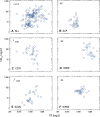The influence of nutrients and physical habitat in regulating algal biomass in agricultural streams
- PMID: 20143065
- PMCID: PMC2842878
- DOI: 10.1007/s00267-010-9435-0
The influence of nutrients and physical habitat in regulating algal biomass in agricultural streams
Abstract
This study examined the relative influence of nutrients (nitrogen and phosphorus) and habitat on algal biomass in five agricultural regions of the United States. Sites were selected to capture a range of nutrient conditions, with 136 sites distributed over five study areas. Samples were collected in either 2003 or 2004, and analyzed for nutrients (nitrogen and phosphorous) and algal biomass (chlorophyll a). Chlorophyll a was measured in three types of samples, fine-grained benthic material (CHL(FG)), coarse-grained stable substrate as in rock or wood (CHL(CG)), and water column (CHL(S)). Stream and riparian habitat were characterized at each site. TP ranged from 0.004-2.69 mg/l and TN from 0.15-21.5 mg/l, with TN concentrations highest in Nebraska and Indiana streams and TP highest in Nebraska. Benthic algal biomass ranged from 0.47-615 mg/m(2), with higher values generally associated with coarse-grained substrate. Seston chlorophyll ranged from 0.2-73.1 microg/l, with highest concentrations in Nebraska. Regression models were developed to predict algal biomass as a function of TP and/or TN. Seven models were statistically significant, six for TP and one for TN; r(2) values ranged from 0.03 to 0.44. No significant regression models could be developed for the two study areas in the Midwest. Model performance increased when stream habitat variables were incorporated, with 12 significant models and an increase in the r(2) values (0.16-0.54). Water temperature and percent riparian canopy cover were the most important physical variables in the models. While models that predict algal chlorophyll a as a function of nutrients can be useful, model strength is commonly low due to the overriding influence of stream habitat. Results from our study are presented in context of a nutrient-algal biomass conceptual model.
Figures



Similar articles
-
The relative influence of nutrients and habitat on stream metabolism in agricultural streams.Environ Monit Assess. 2010 Sep;168(1-4):461-79. doi: 10.1007/s10661-009-1127-y. Epub 2009 Aug 15. Environ Monit Assess. 2010. PMID: 19685271
-
Assessment of chlorophyll-a as a criterion for establishing nutrient standards in the streams and rivers of Illinois.J Environ Qual. 2008 Feb 11;37(2):437-47. doi: 10.2134/jeq2007.0344. Print 2008 Mar-Apr. J Environ Qual. 2008. PMID: 18268307
-
Response of algal metrics to nutrients and physical factors and identification of nutrient thresholds in agricultural streams.Environ Monit Assess. 2011 Apr;175(1-4):397-417. doi: 10.1007/s10661-010-1539-8. Epub 2010 Jun 25. Environ Monit Assess. 2011. PMID: 20577796
-
[Response Characteristics of Algal Chlorophyll-a to Nitrogen, Phosphorus and Water Temperature in Lake Erhai Based on Quantile Regression].Huan Jing Ke Xue. 2017 Jan 8;38(1):113-120. doi: 10.13227/j.hjkx.201607041. Huan Jing Ke Xue. 2017. PMID: 29965037 Chinese.
-
Relationships among nutrients, chlorophyll-a, and dissolved oxygen in agricultural streams in Illinois.J Environ Qual. 2006 May 31;35(4):1110-7. doi: 10.2134/jeq2005.0433. Print 2006 Jul-Aug. J Environ Qual. 2006. PMID: 16738396
Cited by
-
Relationships between diatom metrics based on species nutrient traits and agricultural land use.Environ Monit Assess. 2019 Mar 19;191(4):228. doi: 10.1007/s10661-019-7357-8. Environ Monit Assess. 2019. PMID: 30888530
-
Land use scenarios, seasonality, and stream identity determine the water physicochemistry of tropical cloud forest streams.PeerJ. 2023 Jun 5;11:e15487. doi: 10.7717/peerj.15487. eCollection 2023. PeerJ. 2023. PMID: 37304864 Free PMC article.
-
Prioritizing river basins for nutrient studies.Environ Monit Assess. 2024 Feb 9;196(3):248. doi: 10.1007/s10661-023-12266-7. Environ Monit Assess. 2024. PMID: 38332337 Free PMC article.
-
Influence of Environmental Factors on Biotic Responses to Nutrient Enrichment in Agricultural Streams.J Am Water Resour Assoc. 2010 Jun;46(3):498-513. doi: 10.1111/j.1752-1688.2010.00430.x. J Am Water Resour Assoc. 2010. PMID: 22457568 Free PMC article.
-
Ecological River Health Assessment Using Multi-Metric Models in an Asian Temperate Region with Land Use/Land Cover as the Primary Factor Regulating Nutrients, Organic Matter, and Fish Composition.Int J Environ Res Public Health. 2022 Jul 29;19(15):9305. doi: 10.3390/ijerph19159305. Int J Environ Res Public Health. 2022. PMID: 35954657 Free PMC article.
References
-
- Arar EJ, Collins GB. U.S. Environmental Protection Agency Method 445.0. In vitro determination of chlorophyll a and pheophytin a in marine and freshwater algae by fluorescence, Revision 1.2. U.S. Environmental Protection Agency, National Exposure Research Laboratory. Cincinnati, OH: Office of Research and Development; 1997.
-
- Biggs BJF. The contribution of flood disturbance, catchment geology, and landuse to the habitat template of periphyton in stream ecosystems. Freshwater Biology. 1995;33:419–438. doi: 10.1111/j.1365-2427.1995.tb00404.x. - DOI
-
- Biggs BJF. Patterns in benthic algae in streams. In: Stevenson RJ, Bothwell ML, Lowe RL, editors. Algal ecology: freshwater benthic ecosystems. San Diego, CA: Academic Press; 1996. pp. 31–76.
-
- Biggs BJF, Close ME. Periphyton biomass dynamics in gravel bed rivers: the relative effects of flows and nutrients. Freshwater Biology. 1989;22:209–231. doi: 10.1111/j.1365-2427.1989.tb01096.x. - DOI
Publication types
MeSH terms
Substances
LinkOut - more resources
Full Text Sources

